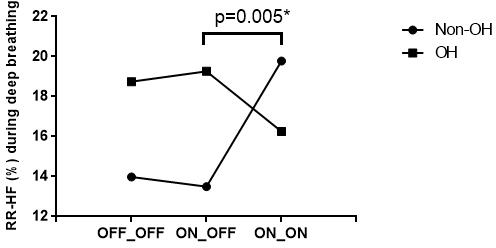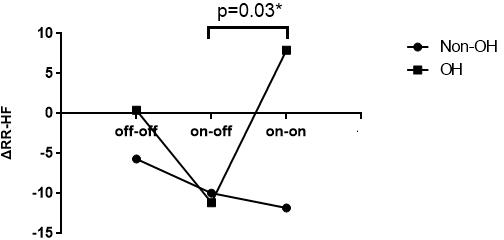Session Information
Date: Monday, June 20, 2016
Session Title: Parkinson's disease: Non-motor symptoms
Session Time: 12:30pm-2:00pm
Location: Exhibit Hall located in Hall B, Level 2
Objective: To explore the effects of STN-DBS and levodopa on cardiovascular autonomic function in PD.
Background: Cardiovascular autonomic dysfunction has been shown in patients with PD. STN-DBS and levodopa are widely used in PD, but their effects on cardiovascular autonomic function are still to be clarified.
Methods: 26 PD patients who had received bilateral STN-DBS and in a stable state were examined under DBS off and dopaminergic medication off (off-off), DBS on and dopaminergic medication off (on-off), and DBS on and medication (levodopa) on (on-on) statuses. 13 patients had OH during the head-up tilt test. We recorded continuously blood pressure, ECG and respiration at rest, during deep breathing, and head-up tilt test. Baroreflex sensitivity (BRS) and spectral analyses were performed via Trigonometric regressive spectral analysis.
Results: Using repeated measures ANOVA, we found: 1. The influences of STN-DBS and levodopa. For measures during tilt-up, RR-HF (high frequency) was higher, while SBP-LF (low frequency) and RR-LF/HF ratio were lower under on-on status compared with on-off. RR-LF/HF ratio at rest was lower under on-off and on-on statuses, compared with off-off. 2. An interactions between levodopa and whether with OH. From on-off to on-on, BRS increased in patients without OH, but decreased in patients with OH. After controlling age and drugs affecting cardiovascular system in the analysis, all the above findings were non-significant (several were marginally non-significant). However, we have new findings: during deep breathing, levodopa increased RR-HF in patients without OH and decrease RR-HF in patients with OH (fig1), and RR-LF/HF ratio changed concomitantly.  The change of RR-HF from supine position to tilt-up was also affected by levodopa and OH status. Levodopa enhanced the decline of RR-HF during tilt-up from pre-tilt status in patients without OH, while reversed this change in patients with OH (fig 2).
The change of RR-HF from supine position to tilt-up was also affected by levodopa and OH status. Levodopa enhanced the decline of RR-HF during tilt-up from pre-tilt status in patients without OH, while reversed this change in patients with OH (fig 2). 
Conclusions: 1. STN-DBS and levodopa have different effects on cardiovascular autonomic function in PD. 2. Cardiovascular autonomic function of patients with and without OH responds differently to levodopa. 3. Age and accompanying medications affecting cardiovascular system may have influences in cardiovascular responses to STN-DBS and levodopa in PD; we should pay more attention to their influences in future studies.
To cite this abstract in AMA style:
K. Li, M. Wolz, R. Haase, H. Reichmann, T. Ziemssen. The influences of STN-DBS and levodopa on cardiovascular autonomic function in patients with Parkinson’s disease: Evaluated by trigonometric regressive spectral analysis [abstract]. Mov Disord. 2016; 31 (suppl 2). https://www.mdsabstracts.org/abstract/the-influences-of-stn-dbs-and-levodopa-on-cardiovascular-autonomic-function-in-patients-with-parkinsons-disease-evaluated-by-trigonometric-regressive-spectral-analysis/. Accessed December 14, 2025.« Back to 2016 International Congress
MDS Abstracts - https://www.mdsabstracts.org/abstract/the-influences-of-stn-dbs-and-levodopa-on-cardiovascular-autonomic-function-in-patients-with-parkinsons-disease-evaluated-by-trigonometric-regressive-spectral-analysis/
